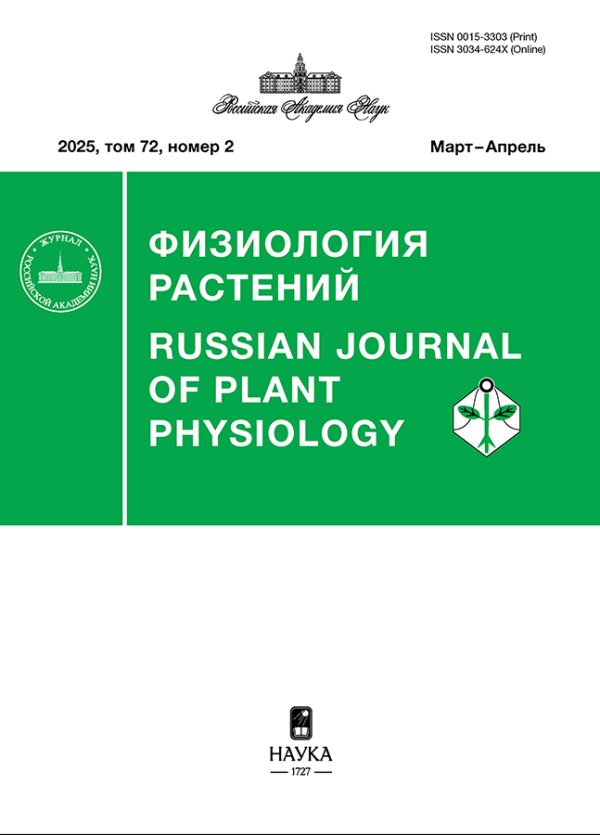Interaction of Soluble and Immobilized Manganese-Stabilizing PsbO Protein with Manganese Ions and Isolated D1/D2/cyt b559 Complex of the PSII Reaction Center
- Authors: Khristin M.S.1, Smolova T.N.1
-
Affiliations:
- Institute of Basic Biological Problems, Scientific Center for Biological Research, Russian Academy of Sciences
- Issue: Vol 70, No 1 (2023)
- Pages: 27-35
- Section: ЭКСПЕРИМЕНТАЛЬНЫЕ СТАТЬИ
- URL: https://journals.rcsi.science/0015-3303/article/view/130196
- DOI: https://doi.org/10.31857/S0015330322600383
- EDN: https://elibrary.ru/ALUOKO
- ID: 130196
Cite item
Full Text
Abstract
Interaction of water-soluble and immobilized (on BrCN-activated agarose) manganese-stabilizing protein PsbO with Mn2+ and Mn3+ cations and with preparations of D1/D2/cyt b559 reaction center (RC) of photosystem II was studied. By native electrophoresis, the formation of dimeric and aggregated forms of PsbO protein were found in the presence of Mn2+, Mg2+, or Fe2+ ions. The dimerization of PsbO occurred after ultraviolet irradiation of the protein preparation. The presence of protein-bound Mn3+ cations increased the electrostatic interaction of the immobilized PsbO with the RC. This was evidenced to by higher amounts of CaCl2 that were required for dissociation of the PsbO–RC complex. It was first demonstrated that the protein exhibited superoxide dismutase (SOD) activity after an electrophoresis in PAAG upon incubation of the gel in an Mn2+-containing solution. Tetrazolium-reductase activity was also ascertained in the protein after its electrophoresis in a mixture with preparations of the oxygen-evolving complex (OEC). It is suggested that the protein interaction with Mn ions and superoxide radicals, as well as short-term UV irradiation, reduces tyrosine and a disulfide bond in the PsbO protein. This yields tyrosil radical and SH-groups participating in redox reactions with ETC components. The interactions of PsbO with Mn cations and UV light, taking place in the chloroplast thylakoids, may regulate the protein binding to RC, modify structural organization of the protein, and promote its participation in alternative pathways of electron transport under the influence of stress factors. The hypothetical scheme of interaction of the immobilized PsbO protein with Mn ions and RC is discussed.
About the authors
Mikhail S. Khristin
Institute of Basic Biological Problems, Scientific Center for Biological Research, Russian Academy of Sciences
Author for correspondence.
Email: smolova_20@rambler.ru
Russian Federation, Pushchino
Tatiana N. Smolova
Institute of Basic Biological Problems, Scientific Center for Biological Research, Russian Academy of Sciences
Email: smolova_20@rambler.ru
Russian Federation, Pushchino
References
- Kuwabara T., Murata N. An improved purification method and a further characterization of the 33-kilodalton protein of spinach chloroplast // BBA. 1982. V. 680. P. 210.
- Yamamoto Y., Doi M., Tamura N., Nishimura M. Released of polypeptides from highly active O2-evolving photosystem-2 preparation by Tris treatment // FEBS Letters. 1981. V. 133. P. 265.
- Miyao M., Murata N. The mode of binding of three extrinsic proteins of 33 kDa, 23 kDa and 18 kDa in the photosystem II complex of spinach // BBA. 1989. V. 977. P. 315. https://doi.org/10.1016/S0005-2728(89)80086-6
- Yamamoto Y., Shinkai H., Isogai Y., Matsuura K., Nishimura M. Isolation of an Mn-carrying 33-kDa protein from an oxygen-evolving photosystem-preparation by phase partitioning with butanol // FEBS Letters. 1984. V. 175. P. 429.
- Шутова Т.В., Христин М.С., Опанасенко В.К., Ананьев Г.М., Климов В.В. Протон-акцепторные свойства водорастворимого белка 33 кДа фотосистемы 2 шпината // Биологические мембраны. 1992. Т. 9. С. 836.
- Commet A., Boswell N., Yocum C.F., Popelka H. pH optimum of the photosystem II H2O oxidation reaction: effects of PsbO, the manganese-stabilizing protein, Cl– retention, and deprotonation of a component required for O2 evolution activity // Biochemistry. 2012. V. 51. P. 3808. https://doi.org/10.1021/bi201678m
- Pazos F., Heredia P., Valencia A., De las Rivas J. Threading Structural Model of the Manganese-Stabilizing Protein PsbO Reveals Presence of Two Possible b-Sandwich Domains // Proteins: Structure, Function, and Genetics. 2001. V. 45. P. 372.
- Berthold D.A., Babcock G.T., Yocum C.F. A highly resolved, oxygen-evolving photosystem II preparations from spinach thylakoids membranes, EPR and electron-transport properties // FEBS Lett. 1981. V. 134. P. 231.
- Khristin M.S., Nikitishena O.V., Smolova T.N., Zastrizhnaya O.M. Extraction of functionally active Photosystem II pigment-protein complexes from pea thylakoids and their purification on Sepharose DEAE 6B // Biol. Membr. (Moscow). 1997. V. 14. P. 133.
- Beauchamp C., Fridovich I. Superoxide dismutase: improved assays and an assay applicable to acrylamide gels // Analytical Biochemistry. 1971. V. 44. P. 276. https://doi.org/10.1016/0003-2697(71)90370-8
- Malencik D.A., Anderson S.R. Dityrosine as a product of oxidative stress and fluorescent Oxidative Dimerization at Tyrosine by a Water-Soluble 4-Amino-1,8-naphthalimide // Chembiochem. 2021. V. 22. P. 2703. https://doi.org/10.1002/cbic.202100193
- Malencik D.A., Anderson S.R. Dityrosine formation in calmodulin: cross-linking and polymerization catalyzed by Arthromyces peroxidase // Biochemistry. 1996. V. 35. P. 4375. https://doi.org/10.1021/bi9526037
- Keyes E.D., Kauser K., Warner K.S., Roberts A.G. Photosensitized oxidative dimerization at tyrosine by a water-soluble 4-amino-1,8-naphthalimide // ChemBioChem. 2021. V. 22. P. 2703.
- Betts S.D., Ross J.R., Hall K.U., Pichersky E., Yocum C.F. Functional reconstitution of photosystem II with recombinant manganese-stabilizing proteins containing mutations that remove the disulfide bridge // BBA. 1996. V. 1274. P. 135. https://doi.org/10.1016/0005-2728(96)00023-0
- Cao P., Xie Y., Li M., Pan X., Zhang H., Zhao X., Su X., Cheng T., Chang W. Crystal structure analysis of extrinsic PsbP protein of photosystem II reveals a manganese-induced conformational change // Molecular Plant. 2015. V. 8. P. 664. https://doi.org/10.1016/j.molp.2015.01.002
- Lee B.-S., Lasanthi G.D., Jayathilaka P., Huang J.-S., Gupta S. One-dimensional and two-dimensional immobilized metal affinity electrophoresis // Methods Mol. Biol. 2012. V. 869. P. 275. https://doi.org/10.1007/978-1-61779-821-4_23
- Permyakov E.A., Permyakov S.E., Deikus G.Y., Morozova-Roche L.A., Grishchenko V.M., Kalinichenko L.P., Uversky V.N. Ultraviolet Illumination-induced Reduction of α-Lactalbumin Disulfide Bridges // Proteins: Structure, Function, and Genetics. 2003. V. 51. P. 498.
- Tanaka S., Kawata Y., Wada K., Hamaguchi K. Extrinsic 33-Kilodalton Protein of Spinach Oxygen-Evolving Complexes: Kinetic Studies of Folding and Disulfide Reduction // Biochemistry. 1989. V. 28. P. 7188.
- Miyao M., Murata N. Effect of urea on Photosystem II particles. Evidence for an essential role of the 33 kilodalton polypeptide in photosynthetic oxygen evolution // BBA. 1984. V. 765. P. 253.
- Kuwabara T., Miyao M., Murata T., Murata N. The function of 33-kDa protein in the photosynthetic oxygen-evolution system studied by reconstitution experiments // BBA. 1985. V. 806. P. 283. https://doi.org/10.1016/0005-2728(85)90107-0
- Hutchison R.S., Steenhuis J.J., Yocum Ch.F., Razeghifard M.R., Barry B.A. Deprotonation of the 33-kDa, extrinsic, manganese-stabilizing subunit accompanies photooxidation of manganese in photosystem II // J. Biol. Chem. 1999. V. 274. P. 31987.
- Zhang F., Gao J., Weng J., Tan C., Ruan K., Xu Ch., Jiang D. Structural and Functional Differentiation of Three Groups of Tyrosine Residues by Acetylation of N-Acetylimidazole in Manganese Stabilizing Protein // Biochemistry. 2005. V. 44. P. 719. https://doi.org/10.1021/bi0483559
- Seidler A. Intermolecular and intramolecular interactions of the 33-kDa protein in photosystem II // Eur. J. Biochem. 1996. V. 242. P. 485.
- Isogai Y., Yamamoto Y., Yamamoto Y., Nishimura M. Isolation of photosystem II reaction center complex by affinity chromatography with the peripheral 33-kDa polypeptide as ligand // FEBS Letters. 1987. V. 224. P. 71.
- Gounaris K., Chapman D.J., Barber J. The interaction between the 33 kDa manganese-stabilising protein and the D1/D2 cytochrome b-559 complex // FEBS Letters. 1988. V. 234. P. 374.
- Lorch S., Capponi S., Pieront F., Bondar A.N. Dynamic Carboxylate/Water Networks on the Surface of the PsbO Subunit of Photosystem II // J. Phys. Chem. B. 2015. V. 119. P. 12172. https://doi.org/10.1021/acs.jpcb.5b06594
- Guerra F., Siemers M., Mielack C., Bondar A.N. Dynamics of Long-Distance Hydrogen-Bond Networks in Photosystem II // J. Phys. Chem. B. 2018. V. 122. P. 4625.
- Shitov A.V., Pobeguts O.V., Smolova T.N., Allakhverdiev S.I., Klimov V.V. Manganese-dependent carboanhydrase activity of photosystem II proteins // Biochemistry (Moscow). 2009. V. 74. P. 509.
- Lu Y.-K., Theg S.M., Stemler A.J. Carbonic Anhydrase Activity of the Photosystem II OEC33 Protein from Pea // Plant Cell Physiol. 2005. V. 46. P. 1944. https://doi.org/10.1093/pcp/pci209
- Liu K., Sun J., Song Y., Liu B., Xu Y., Zhang Sh., Tian Q., Liu Y. Superoxide, hydrogen peroxide and hydroxyl radical in D1/D2/cytochrome b-559 Photosystem II reaction center complex // Photosynth. Res. 2004. V. 81. P. 41.
- Das A.B., Nagy P., Abbott H.F., Winterbourn Ch.C., Kettle A.J. Reactions of superoxide with the myoglobin tyrosyl radical // Free Radical Biology and Medicine. 2010. V. 48. P. 1540.
- Offenbacher A.R., Polander B.C., Barry B.A. An Intrinsically Disordered Photosystem II Subunit, PsbO, Provides a Structural Template and a Sensor of the Hydrogen-Bonding Network in Photosynthetic Water Oxidation // J. Biol. Chem. 2013. V. 288. P. 29056. https://doi.org/10.1074/jbc.M113.487561
- Nagao R., Suzuki T., Okumura A., Niikura A., Iwai M., Dohmae N., Tomo T., Shen J.R., Ikeuchi M., Enami I. Topological Analysis of the Extrinsic PsbO, PsbP and PsbQ Proteins in a Green Algal PSII Complex by Cross-Linking with a Water-Soluble Carbodiimide // Plant Cell Physiol. 2010. V. 51. P. 718. https://doi.org/10.1093/pcp/pcq042
- Leuschner C., Bricker T.M. Interaction of the 33 kDa Extrinsic Protein with Photosystem II: Rebinding of the 33 kDa Extrinsic Protein to Photosystem II Membranes Which Contain Four, Two, or Zero Manganese per Photosystem II Reaction Center // Biochemistry. 1996. V. 35. P. 4551. https://doi.org/10.1021/bi9522615
- Semin B.K., Podkovirina T.E., Davletshina L.N., Timofeev K.N. Ivanov I.I., Rubin A.B. The extrinsic PsbO protein modulates the oxidation/reduction rate of the exogenous Mn cation at the high-affinity Mn-binding site of Mn-depleted PSII membranes // J. Bioenerg. Biomembr. 2015. V. 47. P. 361. https://doi.org/10.1007/s10863-015-9618-8
- Odom W., Bricker T.M. Interaction of CPa-1 with the manganese-stabilizing protein of Photosystem II: identification of domains cross-linked by 1-ethyl-3-[3-(dimethylamino) propyl] carbodiimide // Biochemistry. 1992. V. 31 P. 5616.
- Murakami R., Ifuku K., Takabayashi A., Shikanai T., Endo T., Sato F. Functional dissection of two Arabidopsis PsbO proteins PsbO1 and PsbO2 // FEBS J. 2005. V. 272. P. 2165.
- Raval M.K., Ramaswamy N.K., Nair P.M. Mechanism of Mn II oxidation by the extrinsic 33 kDa protein of photosystem II // Plant Science. 1994. V. 98. P. 141.
- Gerland L., Friedrich D., Hopf L., Donovan E.J., Wallmann A., Erdmann N., Diehl A., Bommer M., Buzar K., Ibrahim M., Schmieder P., Dobbek H., Zouni A., Bondar A.-N., Dau H., Oschkinat H. pH-Dependent Protonation of Surface Carboxylates in PsbO Enables Local Buffering and Triggers Structural Changes // Chembiochem. 2020. V. 21. P. 1597. https://doi.org/10.1002/cbic.201900739
- Commet A., Boswell N., Yocum C.F., Popelka H. pH Optimum of the Photosystem II H2O Oxidation Reaction: Effects of PsbO, the Manganese-Stabilizing Protein, Cl− Retention, and Deprotonation of a Component Required for O2 Evolution Activity // Biochemistry. 2012. V. 51. P. 3808. https://doi.org/10.1021/bi201678m
Supplementary files
















